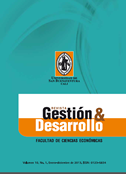La Revista Gestión & Desarrollo proporciona acceso abierto e inmediato a su contenido, basada en el principio de ofrecer al público un acceso libre a las investigaciones para ayuda a un mayor intercambio global de conocimiento.
Excepto que se establezca de otra forma, el contenido de esta revista cuenta con una licencia Creative Commons Attribution-NonCommercial-NoDerivatives 4.0 International (CC BY-NC-ND 4.0) que puede consultar en http://creativecommons.org/licenses/by-nc-nd/4.0/
- Attribution — You must give appropriate credit, provide a link to the license, and indicate if changes were made. You may do so in any reasonable manner, but not in any way that suggests the licensor endorses you or your use.
- NonCommercial — You may not use the material for commercial purposes.
- NoDerivatives — If you remix, transform, or build upon the material, you may not distribute the modified material.
- No additional restrictions — You may not apply legal terms or technological measures that legally restrict others from doing anything the license permits.
Abstract
This paper is a proposal for an adaptation of Gary Hamel business model theory, applied to small metal-mechanic sector companies, in order to improve their competitiveness in an environment where competing companies in the Colombian market are those with whose countries have signed FTAs, countries located in the top ten rankings of competitiveness. This implies that these small businesses must be prepared to compete with strong innovation. The proposal includes a step-by-step that small metal-mechanic companies must implement to be more creative, innovative and competitive; a link between the Gary Hamel business model and Norton and Kaplan strategic maps with a Balanced Scorecard, with examples based on qualitative researches to companies in the sector. Although the proposal includes a template designed in Excel, this article aims to explain to the business owner how it is possible to improve its competitiveness in a practical way and applied to the business.
References
[2] Interview with Henry Payan Payan & Cia Ltda Company Partner, Cali, March 15, 2010.
[3] Interview with Fabio Héctor Muñoz, ASMETALES Company. President, Mumbai, April 7, 2010
[4] RICART J. (2009). “Business Model: The missing link in strategic management”. Article published by the IESE Business School, University of Navarra.
[5] WELLER, J. (2004). “Tertiary sector employment in Latin America: between modernity and survival”. In: Cepal, December , Vol 84, pp. 160,175.
[6] GOLDMARK, L. (1996). BDS: a scheme of analysis. Department of Social Programs and Sustainable Development. Inter-American Development Bank. , p. 1-2
[7] NORTON, D. y KAPLAN, R. (2000). Scorecard:The Balanced Scorecard. Editorial Management.
[8] RIGBY, D. y BILODEAU, B. (2009). Managements Tools and Trends Bain and Company.
[9] Chamber of Commerce of Cali. Slides: Marketing, forced a path for survival of SMEs in the Cauca Valley, A Look to face globalization processes.
[10] JOHNSIN, M.; CHRISTENSEN, C. y KAGERMANN, H. (2008). “As reinvent its business model” . In: Harvard Business Review. pp. 53,63.
[11] HISRICH, R. y PETERS, M. (1989). Satrting Entrepreneurship, Developing and Mananging to New Enterprise. Richard D. Irwin Inc, Homewood.
[12] VARELA, R. (2008). Business Innovation, Art and Science in Entrepreneurship. Third Edition.
[13] National Planning Department. So will the National Competitiveness Policy, Document 1, Government and Private Sector, allies for a more competitive business environment. March 2009
[14] RYANS, A. y VANDENSBOSCH, M. (2000). “Compaq Computer Corp.: The Dell Challenge”. In: Harvard Business Review. July 12.
[15] URZOLA, A. (2001). “Development of a model for the development of the business plan in SMEs”. Working Magister degree in Business









